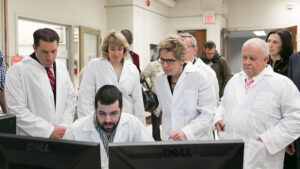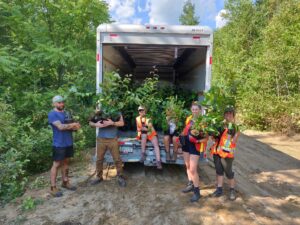
We are bringing your attention to a recent CBC story on a study and comments by University of Alberta ecologist, David Schindler on the effects that the tar sands oil developments appear to be having on the Athabasca River in northern Alberta.
The Athabasca has supported a subsistence fishery for first nations communities for centuries, and since the development of the tar sands, cancerous and mutated fish have been seen in rising numbers, naturally raising concerns about human and food safety.
Since the Federal Government has chosen the Alberta tar sands as the economic engine of Canada, it has coincidentally (?) begun a systematic elimination of scientific resources available to academics, like Dr. Schindler and others, as well as the general public, that could provide hard evidence of the ecological, health and social impacts of its policy decisions.
The article specifically references the “Experimental Lakes Area”, an 84hectare area of 58 small lakes and their drainage established in 1969.
The ELA occupies a unique position not only in Canada, but globally as the only dedicated research facility for ecosystem-scale investigations and long term monitoring of ecosystem processes. Since its establishment, it has produced over 1100 publications, ranging from peer reviewed papers for scientific journals, to presentations for public awareness and education.
For over twenty years this facility has been conducting important, ongoing studies on water interactions with chemical and biological contaminants of the very sort that the tar sands plants appear to be leeching into the Athabasca River.
Although global in its reach and costing only a few hundred thousand dollar a year in maintenance funding (all the studies are self supporting financially), the federal government has withdrawn its funding and scheduled the ending of the facility and all research taking place there.
The facility was scheduled to be dismantled and twenty years of research was about to be lost, taking with it all of the information on causes and effects, as well as possible solutions, to, among other things perhaps, the curious mutant fish.
Our Federal Government has seemed intent on cutting us off from the means to understand and question its motives, its rationale, and the efficacy of its decisions on the economy as it pertains to our health and well being. Witness the muzzling of Federal scientists, the elimination of the long form census, and this now this attempt at closure of a low cost, highly productive, world renowned study facility.
Happily, just this yesterday morning, the Governments of Manitoba and Ontario stepped in to keep the facility in operation for 2013, while seeking support and cooperation from the International Institute for Sustainable Development to safeguard this valuable resource.
We cannot make informed decisions without information, but we could certainly be led like cattle to an unhappy outcome. Please read these articles, and make your opinion known on measures that reduce the free access to and the availability to produce scientific research in this country, to your MP.
Click here for more details on yesterday’s announcement.

